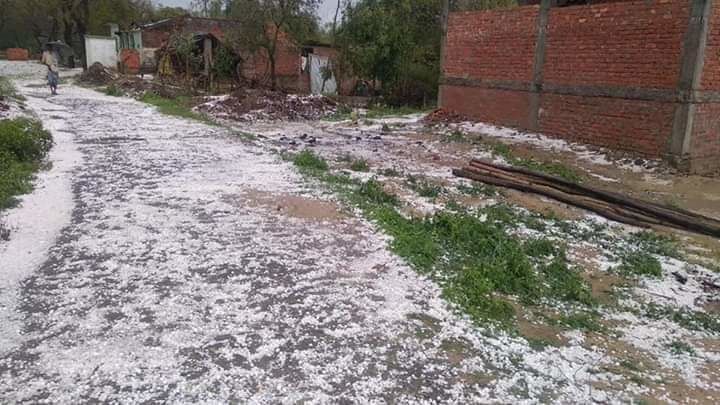Merely 10 minutes of hailstorm buried hopes of these farmers in Uttar Pradesh, Bundelkhand
While the world is worried about the Coronavirus outbreak, unseasonal rainfall and hailstorm in many states in the first half of March has ruined the lives of the farmers


Lucknow/ Sitapur/Lalitpur/Sonbhadra/Barabanki
“I have been working as a farmer for the past 20-25 years, but I have not seen such huge hail stones until today. The hailstorm lasted for only 10 minutes, but there was a white blanket on our fields,” said Nandu Pandey, 45, a farmer from Gopalapur in Sitapur district in Uttar Pradesh.
Nandu lives in the same Sitapur district in Uttar Pradesh where five persons were killed in lightning amid heavy hailstorm on the morning of March 13. In Uttar Pradesh alone, 28 people were killed on March 12-13.
In many states of India, there have been several bouts of unseasonal rains, hailstorm and strong winds, which have caused heavy damage to crops of wheat, mustard, gram, barley, lentils, banana and vegetables in several states including Punjab, Haryana, Uttar Pradesh, Madhya Pradesh, Bihar, Chhattisgarh. Earlier, on February 29, hailstones fell in several parts of the country, including Nashik in Maharashtra. Due to incessant crop losses in many parts of the country, it was a black Holi for the farmers.”
Amar Nath Mishra, who is a technical officer in the Agriculture Meteorological Department, which is associated with the Met department, and the nodal officer at the Narendra Dev Agricultural University in Ayodhya informed: “The weather has been changing continuously. Since January, 160 millimeters of rain has been reported till now. It is almost double the rainfall during this time for the past several years.”
He added: “Rain and hailstorm are likely to reduce crop production by 30 per cent in 11 districts, including Barabanki, in our zone. The fall of wheat is harmful. Those farmers are also affected who couldn’t dig up their crops of mature potato.”
Girija Prasad Vishwakarma, a farmer from Aswanpur village in Barabanki district of Uttar Pradesh, said: “Wheat, ramdana and mustard crops have been so badly ruined that nothing can be salvaged from the fields.” Here, hailstones accompanied with heavy rains in March have damaged potato and wheat crop.

Barabanki’s additional district magistrate, Sandeep Kumar Gupta, informed that due to unseasonal rains and hailstorm during March 1 to March 13, 4,079 hectares of wheat, potato, tomato and mustard crops of 21,278 farmers of the district have been damaged, estimating a loss of about Rs 20 crore. On March 13, district magistrate Dr Adarsh Kumar had observed after his tour of the region: “There has been a substantial damage in the district. Many fields have suffered total loss of crops. Will send a report soon to the relief commissioner for the immediate relief to the farmers and reach out to the farmers as soon as the relief is approved.
The crop wastage figures due to the weather have not yet been released at the national level. But the worst loss till the first of March 13-14 was registered in Rajasthan. According to the Agriculture Department of Rajasthan, crops spread over 4,53,000 hectares have been ruined.
Virendra Singh Parihar, an agricultural journalist based in Rajasthan, informed Gaon Connection: “The state has suffered losses in 19 districts due to rain and hailstorm. This loss ranges between 5 per cent and 90 per cent, but on an average, the crop production would be reduced by at least 30 per cent this time.
The India Meteorological Department (IMD) has expressed fears that the production of crops in Rabi season may be reduced due to unseasonal rains and hailstorm.
“There may be fear of Coronavirus all over the country, but as farmers, we do not have a bigger ruin than this. There is little hope for us now,” said Nandu Pandey.
This is the second successive year for the farmers of India when the weather has caused them huge losses. In the drought-hit Bundelkhand of Uttar Pradesh, Lalji, an elderly farmer of Lalitpur, breaks down while telling about his loss due to the weather. Lalji, sitting amid his chana field, said: “With this crop ruined too, God only knows what would happen next”

In Bundelkhand, there has been a lot of damage to the pulse crops.
Lalji’s tears tell the tragedy of farmers from Bundelkhand and elsewhere in India. Arvind Kumar Niranjan, a farmer from Semara village in Lalitpur informed: “Chana, masoor, mustard — nothing was spared. In the rainy season, urad crop got bust, now the pulses crops are damaged.”
In September-October 2019, the urad crop was damaged in the Bundlekhad region due to excessive rainfall, which led to many farmer suicides in several districts of Bundelkhand, including Lalitpur and Banda. The farming households couldn’t celebrate Diwali and the summer migration to the cities began in October itself.
The Bundelkhand region formed by merging certain regions of Uttar Pradesh and Madhya Pradesh, Latur and Usmanabad in Maharashtra, Kalburgi in Karnataka, Mokama belt in Bihar, undertakes large-scale cultivation of pulses crops every year, but the rains of 2019 and 2020 have been a severe setback to India’s pulses mission. India produced about 23.40 million tonnes of pulses in 2018-29, while our national consumption is 26-27 million tonnes. The central government had set a target of 26.30 million tonnes for the current year, but the weather change could upset it.
Madhya Pradesh also saw rain and hailstorm on March 13. Shivam Baghel, a young farmer from Seoni, said: “The harvesting of Chana and Tevada (pulses crop) was going on, only those crops that had left the fields could survive. Hardly any crop of the remaining farmers could be salvaged. There had twice been a hailstorm for about 20 minutes.” The crops have also suffered a lot in Chaurai of Chhindwara district in Madhya Pradesh besides Seoni.
Report: Arvind Shukla, Mithilesh Dhar, Mohit Shukla, Arvind Parmar, Virendra Singh, Deepak Singh, Bhim Kumar, Mohammad Shanu

